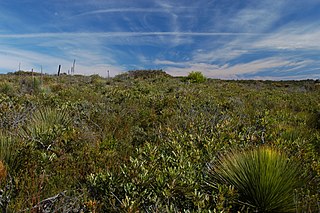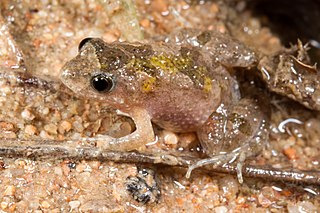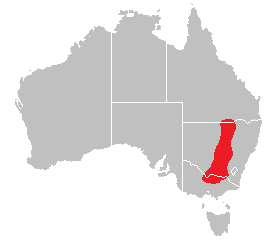
Crinia is a genus of frog, native to Australia, and part of the family Myobatrachidae. It consists of small frogs, which are distributed throughout most of Australia, excluding the central arid regions. Many of the species within this genus are non-distinguishable through physical characteristics, and can only be distinguished by their calls.

The common eastern froglet is a very common, Australian ground-dwelling frog, of the family Myobatrachidae.

Geocrinia is a genus of frogs in the family Myobatrachidae. These frogs are endemic to Australia. Two species are known from southeastern Australia, while one is known from southeastern Western Australia.

The Tasmanian froglet is a species of ground-dwelling frog that occurs only in Tasmania, Australia.

Arakwal National Park is a national park in New South Wales, Australia, 624 km north of Sydney and immediately south of Cape Byron, the most easterly point of mainland Australia. The park protects an area of Wallum country, of coastal clay heaths, between the adjacent town of Byron Bay and east-facing Tallow Beach. It provides habitat to numerous bird species and two native frog species, the Wallum Froglet and Wallum Sedge Frog, both of which are deemed vulnerable to extinction.

The eastern sign-bearing froglet is a small, ground dwelling frog native to eastern Australia.
The streambank froglet or Flinders Ranges froglet is a small, locally common, Australian ground-dwelling frog, of the family Myobatrachidae.

Wallum, or wallum country, is an Australian ecosystem of coastal south-east Queensland, extending into north-eastern New South Wales. It is characterised by flora-rich shrubland and heathland on deep, nutrient-poor, acidic, sandy soils, and regular wildfire. Seasonal changes in the water table due to rainfall may create swamps. The name is derived from the Kabi word for the wallum banksia.

The desert froglet is a species of frog in the family Myobatrachidae, endemic to Australia. Desert froglets occur mainly in dry or moist savanna habitats, principally from the mid-western border of Northern Territory, south-east into western Queensland and New South Wales and the north-east corner of South Australia. They can also be found along the Queensland coast where it has been recorded between Townsville and Cooktown, and as far south as Hervey Bay.

The quacking frog also known as the red-thighed froglet due to its legs tending to be bright red. It is a species of frog from the Myobatrachidae family and is in a clad with five other species. The frog is well known for the sound it produces which resembles a quack. It has up to 11 notes and can change the notes in their call. It has larger testes compared to other frogs within the genus and has started to be used in experiments. This frog is found in southwest Australia. It is found in ponds and pools and other moisture filled areas. These frogs engage in polyandry and can result in multiple paternity of its offspring. Additionally, the tadpoles of this species can change the rate they metamorphosize depending on the conditions. The males tend to have larger arm girth and can adopt different mating strategies depending on size. The mating strategy is dependent on male density. The frogs also vary in terms of color and texture of its skin. The tadpoles are generally golden with transparent tails.
Glauert's froglet, rattling froglet or clicking froglet is a species of frog in the family Myobatrachidae. It is endemic to Australia. Its natural habitats are temperate forests, rivers, intermittent rivers, shrub-dominated wetlands, swamps, freshwater lakes, freshwater marshes, arable land, pastureland, plantations, rural gardens, water storage areas, ponds, open excavations, sewage treatment areas, and introduced vegetation. It is threatened by habitat loss.
The sign-bearing froglet is a frog in the family Myobatrachidae. The species was first described by John Alexander Moore in 1954. It is endemic to Australia. Its natural habitats are subtropical or tropical seasonally wet or flooded lowland grassland and swamps. It is threatened by habitat loss.
The moss froglet, or moss frog, is a species of frog in the family Myobatrachidae. It is endemic to Tasmania. Its natural habitats are moist lowland forests, temperate shrubland, and swamps.
The false western froglet is a species of frog in the family Myobatrachidae. It is endemic to Australia. Its natural habitats are temperate forests, rivers, intermittent rivers, shrub-dominated wetlands, swamps, freshwater lakes, intermittent freshwater lakes, freshwater marshes, intermittent freshwater marshes, freshwater springs, rocky areas, arable land, pastureland, plantations, water storage areas, ponds, open excavations, wastewater treatment areas, seasonally flooded agricultural land, and canals and ditches. It is threatened by habitat loss.
The remote froglet is a species of frog in the family Myobatrachidae. It is found in Australia and New Guinea. Its natural habitats are moist savanna, subtropical or tropical dry lowland grassland, subtropical or tropical seasonally wet or flooded lowland grassland, swamps, freshwater lakes, freshwater marshes, intermittent freshwater marshes, coastal freshwater lagoons, and canals and ditches.

Sloane's froglet is a species of frog in the family Myobatrachidae. It is endemic to Australia. Its natural habitats are subtropical or tropical seasonally wet or flooded lowland grassland and intermittent freshwater marshes in and around the floodplains of the Murray-Darling Basin
The small western froglet is a species of frog in the family Myobatrachidae. It is endemic to Australia. Its natural habitats are temperate forests, subtropical or tropical seasonally wet or flooded lowland grassland, swamps, freshwater lakes, intermittent freshwater lakes, freshwater marshes, and intermittent freshwater marshes. It is threatened by habitat loss.
Anstisia rosea, the karri or roseate frog is a species in the family, Myobatrachidae. It is endemic to Southwest Australia.
The Strike-a-Light River, a perennial stream that is part of the Murrumbidgee catchment within the Murray–Darling basin, is located in the Snowy Monaro Regional Council area of New South Wales, Australia.

The northern Flinders Ranges froglet, or Flinders Springs froglet, is a species of small frog that is endemic to Australia.









